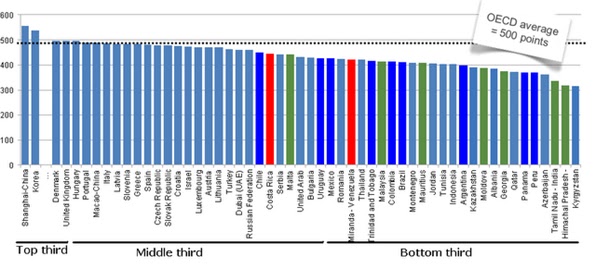The Future of China-Venezuela Relations
China has became a critical economic partner for Venezuela over the past decade.
This post is also available in: Spanish
The Australian Council for Educational Research (ACER) just released the document “PISA 2009 Plus Results: Performance of 15-year-olds in reading, mathematics and science for 10 additional participants,” which presents results from the Program for International Student Assessment (PISA) for countries that participated after the initial round of examinations.
The new participants include two Latin American education systems: Costa Rica and Venezuela’s Miranda Province. It is relevant to note that Miranda-Venezuela did not meet the PISA standard on schools response rate, and that Himachal Pradesh-India and Tamil Nadu-India did not meet PISA standards for student sampling, so caution should be exercised when interpreting results from these education systems.
Mean Scores on PISA Reading Test, 2009
Key: Dark blue: LAC; Green: Second Round Countries; Red: Costa Rica and Venezuela-Miranda
 |
| Sources: OECD (2010) and ACER (2011). Note: Not all differences between countries are statistically significant. |
In August, PREAL summarized the first round of PISA results in “Measuring Up? How Latin America and the Caribbean Performed on the 2009 PISA.” We were curious whether the performance of Costa Rica and Miranda-Venezuela would follow the trend of the nine Latin American and Caribbean (LAC) countries that participated previously. Here are some key observations from the new results:
% of Students at the Lowest Performance Levels on PISA Math Test, 2009
Key: Dark blue: LAC; Red: Costa Rica and Venezuela-Miranda
 |
|
| Sources: OECD (2010) and ACER (2011). Note: Lowest levels include Leve 1 and below. |
Outside of Latin America and the Caribbean, two states in India—Tamil Nadu and Himachal Pradesh—also participated in PISA for the first time. While these two states are not representative of India overall and did not meet PISA standards for student sampling, initial indications seem to suggest that their scores were low, with few high performers. This is contrary to what Pritchett and Viarengo predicted in 2009, when they suggested that India would have low overall scores with significant pockets of high performers. In fact, the share of underperformers for these two states ranged from 82-90% in all subjects.
To be sure, low scores in India and the other new participating countries are troubling. However, we believe that the real value of these new 2009 PISA plus results is that more education systems are taking the crucial first step toward improving education quality by allowing cross-national assessments of their students’ performance. Of course, rankings are simply quick glimpses into how a country is doing compared to others, and it is how governments respond that has the most value.
China has became a critical economic partner for Venezuela over the past decade.
Chinese lending to Latin America and the Caribbean hit an all-time high of $37 billion in 2010.
Venezuelan president Nicolas Maduro left China last month with a supposed show of support from the Chinese government.